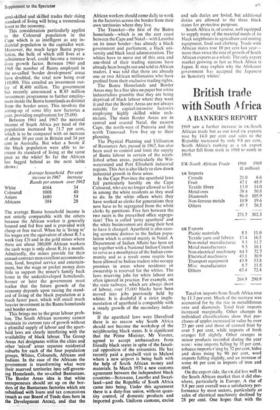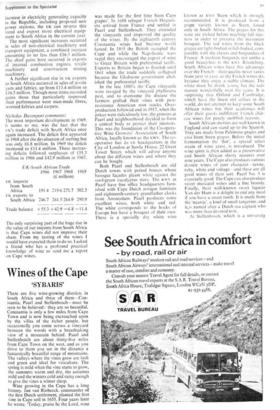British trade with South Africa
A BANKER'S REPORT
1969 saw a further increase in UK-South African trade but as our total UK exports rose by 14.0 per cent and sales to the Republic increased by only 9.8 per cent. South Africa's ranking as a UK export market fell from sixth in 1968 to ninth in 1969.
UK-South African Trade ux Imports 1968 1969 _ (£ million) Cereals 21.0 6.6 Fruit 47.1 48.9 Textile fibres 13.0 14.0 Metal ores 38.4 50.8 Diamonds 96.0 105.9 Non-ferrous metals 10.9 19.6 Others 45 3 56.5 271.7 302.3 UK Exports Plastic materials 8.5 11.0 -Textile yarn and fabrics 13.4 16.5 Non-metal manufactures 9.3 11.7 Metal manufactures 9.3 10.1 Non-electrical machinery 64.3 72.7 Electrical machinery 43.1 30.9 Transport equipment 43.9 53.8 Misc. manufactures 8.7 11.8 Others 63.4 72.4 264.9 290.9 Total ux imports from South Africa rose by 11.3 per cent. Much of the increase was accounted for by the rise in metalliferous ores and diamonds. Total fruit imports increased marginally. Other changes in individual classifications show that pur- chases of apples increased in value by over 23 per cent and those of canned fruit by over 5 per cent, while imports of fresh oranges fell slightly. Other oranges in minor products recorded during the year were: wine imports falling by 35 per cent, tobacco imports rising by 32 per cent, hides and skins rising by 90 per cent, wool imports falling slightly, and an increase of some 46 per cent in imports of iron and steel On the export side, the UK did less well in the South African market than it did else- where, particularly in Europe. A rise of 9.8 per cent overall was a satisfactory per- formance by most sectors, particularly as sales of electrical machinery declined by 28 per cent. One hopes that with the increase in electricity generating capacity in the Republic, including proposed new power stations, the UK can reverse this trend and export more electrical equip- ment to South Africa in the current year.
The most significant increases occurred in sales of non-electrical machinery and transport equipment, a combined increase amounting to no less than £16.3 million. The chief gains here occurred in exports of internal combustion engines, textile machinery and construction mining machinery.
A further significant rise in UK exports to South Africa occurred in sales of textile yarn and fabrics, up from £13.4 million to £16.5 million. Though most items recorded gains those that particularly improved their performance were man-made fibres, worsted fabrics and carpets.
Nicholas Davenport comments: The most important development in 1969, it seems to me, was the fact that the ix's trade deficit with South Africa once again increased. The deficit first appeared in 1968 after the devaluation of sterling but was only £6.8 million. In 1969 the deficit increased to £11.4 million. These increas- ing deficits followed surplusses of £55.3 million in 1966 and £42.9 million in 1967.
UK-South African Trade 1966 1967 1968 (£ million) 1969 UK imports from South Africa 191.4 219.6 271.7 302.3 UK exports to South Africa 246.7 261.5 264.9 290.9 Trade balance +55.3 +42.9 —6.8 —11.4 The only surprising part of the huge rise in the value of our imports from South Africa is that Cape wines did not improve their share. From my tasting of the wines I would have expected them to do so. I asked a friend who has a profound practical knowledge of wine to send me a report on Cape wines.























































 Previous page
Previous page